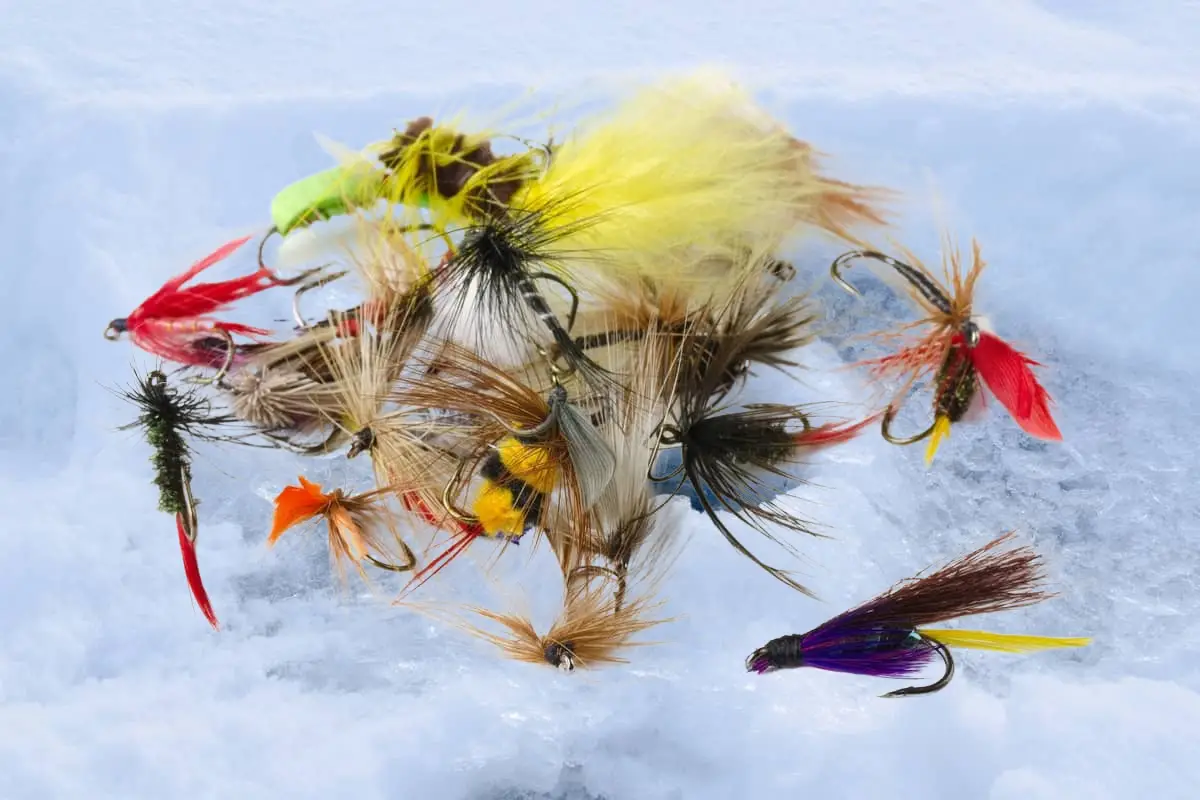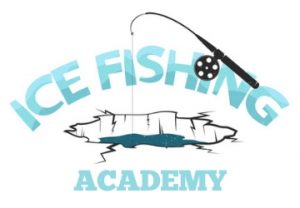If you’ve never used flies while ice fishing, it’s super effective. Ice fishing with fly fishing flies can produce outstanding catches! But how do you use fly rod flies for ice fishing?
A slight twitching movement will imitate an insect when ice fishing with flies. Use 1 to 4 lb micro line when fishing flies. Fish with colorful weighted tungsten ice flies or streamers with a split shot close to the bottom for perch and higher up the water column for crappie, bluegills, and trout.
Flies are a great way to entice fish, and there are fly patterns that attract and land fish more than others. See the different types of flies, what patterns produce more fish, and how to fish them further in this article.
You Can Ice Fish With Flies – Here’s Why!
Flies can be widely used as an artificial lure when ice fishing. A wide variety of fly patterns successfully imitates the small natural insects the fish feed on.
Flies are generally associated with springtime fishing in wide, flowing rivers and small streams, but not much attention is given to ice fishing with flies. That’s a mistake!
During winter, fish beneath thick ice will have limited food supplies. Waterborne insect larvae such as scuds and various nymphs are often observed underwater.
The scud pattern flies are usually one of the most successful patterns you can use when ice fishing with flies.

It’s interesting to note that many anglers disregard the effectiveness of flies for ice fishing purely because they have not tried using them.
There are certain lakes where using bait is prohibited, so artificial lures are best, and flies are highly successful.
What Is a Scud Fly?
The ” scud ” fly is a popular fly used while ice fishing, especially for panfish, is the “scud” fly. A scud will often trigger panfish and trout to bite when other lures and flies fail, although many aren’t sure what scuds are!
Scud flies are tiny crustaceans that resemble freshwater shrimp with small legs that hold to vegetation where fish feed. They range in size from under 1/4″ to over 1″ in length and are found in various colors. Scud flies also imitate caddis larvae that many fish use as a food source.
Tungsten Ice Flies – The Perfect Ice Fly?
Tungsten fishing lures can be a bit pricey for many fishermen, although their advantages outweigh the costs!
Tungsten is a super dense metal, denser than the old lead jigs and weights we used to commonly use. It sinks faster than ice flies tied on a regular hook using beads.
A fly that sinks faster will get down to the fish quicker, which is important when a school of panfish or perch is passing through!
Another advantage of a tungsten fly over lighter-weight flies is the ability to “pound the bottom” of the lake, raising sediment clouds. You also have a better feel for the bottom structure being hard or soft.
With a heavier fly, you will have better line control between you and the tungsten fly, allowing you to present your lure precisely as you want.
Tungsten ice flies are far easier to fish with, and if you lose one on a snag, they are better for the environment than their lead counterparts!
With a heavier fly, you will have better line control between you and the tungsten fly, allowing you to present your lure precisely as you want.
How Do You Rig a Fly for Ice Fishing?
Rigging ice flies for ice fishing is pretty straightforward. The two methods I use when fishing flies are tied directly to the line and using a drop shot.
Rig an Ice Fly Directly to Your Line
When fishing with a lighter approach and a stealth technique when not wanting to spook fish below, I’ll tie directly to my line. This allows a “finesse” presentation and is more of a visual bite for light-biting panfish and trout.
Many people use a clinch knot or a Palomar knot to tie flies to their fishing line because that is what they have been taught and know how to tie easily. But I have a better knot to tie when using ice flies!
Let me introduce you to the Davy Knot!
This is a simple and easily tied knot fly fishermen have been using for a long time.
When my fingers are cold and I lose dexterity with them on the ice, the Davy Knot is an easy knot to tie! I’ll even use them on heavier lines and spoons when I have a difficult time tying other popular knots!
Give this video a quick look, and I’m sure you’ll also be using the Davy Knot!
Now I wouldn’t use the Davy Knot when fishing for larger fish, but for brook, rainbow and other trout, bluegills, and panfish, this is a killer knot for ice flies!
Rig Ice Flies With a Loop and Drop-Shot
When fishing with more than one fly on the ice, the best way to do so is with a drop-shot setup.
- Use a 1/2 oz to 1 oz sinker attached to the end of your line
- Tie a 4″ long loop approximately 12″ above the sinker and a second 4″ long loop 8″ above the bottom loop.
- Attach your ice flies to the loop by passing the loop through the hook eye and around the fly’s body and pull snugly.
With the weight on the bottom of the rig, you can quickly drop the setup to the bottom of the water column. One fly will dance enticingly above the bottom, while the top fly will be 20″ above the bottom.
A drop-shot setup like this will allow you to fish two different patterns and colors of flies while targeting two water column depths.
Ice Fishing Fly Patterns – 5 Top Fly Patterns
It’s hard to determine the best fly pattern that will work every time in every lake, but a few have proven to be successful for the most part. The best-documented and most recommended fly patterns for ice fishing are;
- Blob flies are bulky and short flies made by wrapping colorful fritz around a wide gap, short-shanked hook. The best colors are neon orange, neon pink, and neon yellow.
- Chironomid flies are thin, tightly wound flies with a tungsten bead head for weight. Some patterns have a tail for extra movement to imitate different midges.
- Leech pattern flies will typically include flies like the Wooly Bugger in several colors. The newer flies are tied on jig hooks.
- Chewy worm flies are made from a soft and rubbery chenille material in various high visibility and neon colors. The movement of these flies underwater is unmatched.
- Tungsten scud flies tied with scud tape, scud dub, and flash. They are available in olive, brown, grey/silver, and gold. Some scud flies have a tungsten bead head to let them sink a little faster, while others have no weight and appear very natural underwater.
How To Ice Fish With Flies
The trick with using flies to ice fish is to let them appear as natural as possible. Fish are curious, but they can easily be spooked when a lure does not imitate their typical food. When using any of the listed flies, the most successful way to fish them is as follows;
- Drop your fly down the ice fishing hole and let it sink for a few seconds. You want the fly to be close to the bottom so you can fish it to the mid-water range.
- Use the same light rod for other lures when ice fishing. This will allow for a greater sensitivity to feel a bite.
- Using small upward movements by raising the rod’s tip, you create a natural motion in the water.
- Jig the fly upwards towards the surface and let it sink again for a few seconds.
- Unweighted flies create a much more realistic invertebrate appearance.
- Mostly the fish will grab the fly as it drops.
- Weighted flies that drop to the bottom disturb the silt that attracts fish. If you do not get any bites immediately in the mid-water area, you can try this.
Typically, you would want to match the fish’s food to ensure success. I used to do that by opening up my first catch and look what was inside the stomach. Many times this trick helped me catch ample fish without a hitch.
The natural olives, browns, and black colors of insects are easy to match, but sometimes during a feeding frenzy, it helps to have brightly colored flies on hand. If possible, have two rods available ready for action.
Which Fish Can You Catch When Ice Fishing With Flies?
The flies you will use for ice fishing are slightly adapted because they are impossible to cast, and there is no space for big maneuvers with the rod. The secret here is to make the fly appealing to your target species. The fish most successfully caught on flies are;
- Brown trout
- Rainbow trout
- Pike
- Crappie
- Yellow Perch
- Bluegills
- Walleye
- Largemouth Bass
- Smallmouth Bass
Most panfish have small mouths, so the flies used to catch them should be from a #8 to no bigger than a #14. If the hook is too large, the fish will not grab the lure properly.
Conclusion
If you have never used a fly for ice fishing, there is no time to give it a go like the following winter. Purchase a few different patterns and try them out, and you will most likely have a change of heart about ice fishing with flies. If one does not yield success, try a different pattern until you put them on the ice.
Have fun and stay safe out there!
